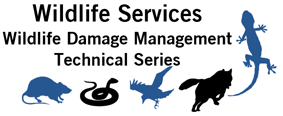U.S. Department of Agriculture: Animal and Plant Health Inspection Service
Date of this Version
5-2018
Document Type
Article
Citation
Lowney, M.S., S.F. Beckerman, S.C. Barras, and T.W. Seamans. 2018. Gulls. Wildlife Damage Management Technical Series. USDA, APHIS, WS National Wildlife Research Center. Fort Collins, Colorado. 16p.
Abstract
Abundant gull (Figure 1) populations in North America have led to a variety of conflicts with people. Gulls cause damage at aquaculture facilities and other properties, and often collide with aircraft. Their use of structures on and near water results in excessive amounts of bird droppings on boats and docks. Their presence near outdoor dining establishments, swimming beaches, and recreational sites can lead to negative interactions with people. Large amounts of gull fecal material pollutes water and beaches resulting in drinking water contamination and swim bans. A combination of dispersal techniques, exclusion and limited lethal control may reduce damage to an acceptable level.
No single management method to prevent gull conflicts works all the time or in all settings. Wildlife management methods should be integrated so that one method enhances the effect of another. For example, frightening devices often are more effective when done in conjunction with habitat modification (e.g., removal of food resources or roosting habitat) to make a site less attractive to gulls. Likewise, exclusion devices, such as overhead wires, work better when combined with covering or removing food resources.
Gulls are classified as a migratory bird species and are protected by federal and, in most cases, state laws. In the United States, gulls may be taken only with a permit issued by the U.S. Fish and Wildlife Service. Occasionally, an additional permit is required from the state wildlife management agency. Permits are issued only after dispersal and other non-lethal damage management methods have been employed and proven ineffective at resolving the conflicts. No federal permit is needed, however, to frighten or mechanically exclude gulls.
Included in
Aquaculture and Fisheries Commons, Behavior and Ethology Commons, Biodiversity Commons, Ornithology Commons, Other Animal Sciences Commons, Other Ecology and Evolutionary Biology Commons, Population Biology Commons, Poultry or Avian Science Commons, Terrestrial and Aquatic Ecology Commons


Comments
US govt work.